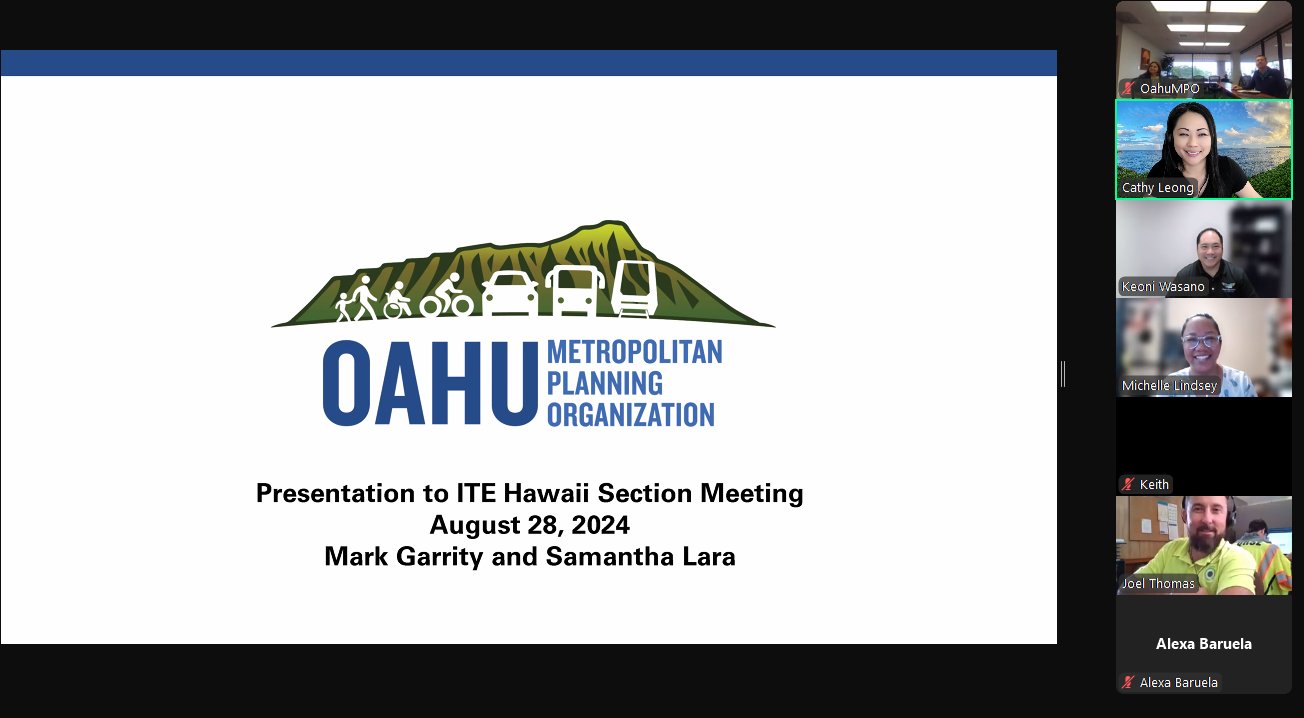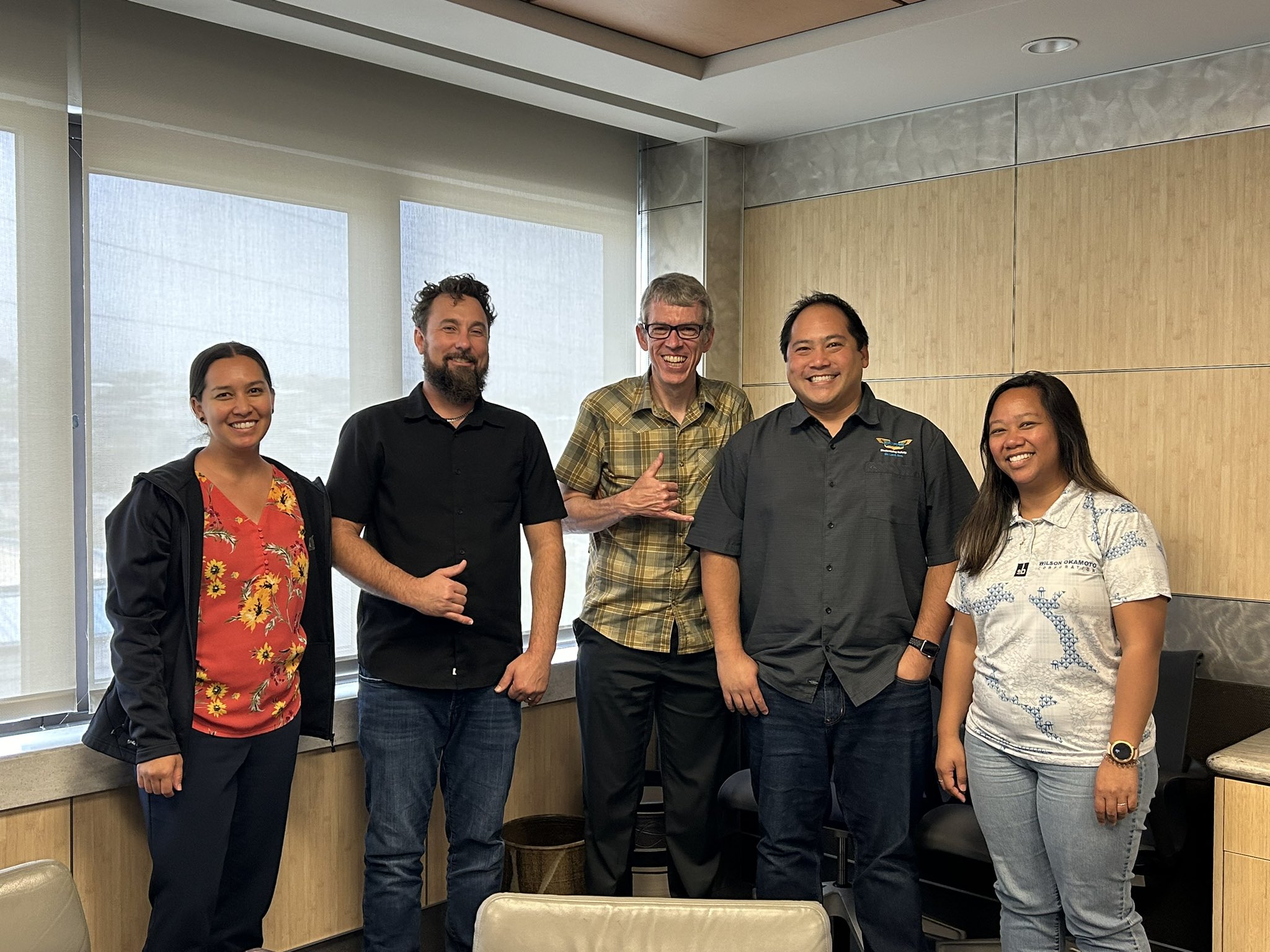October Meeting Summary
The Hawaii ITE had its annual luncheon meeting on October 27, 2010, at the City’s Frank F. Fasi Municipal Building. Based upon a tally of the votes received for the 2010 elections, the following were elected as incoming officers:
Honglong Li, President
Mike Packard, Vice President
Juanita Wolfgramm, Secretary
Sara Toyama, Treasurer
The meeting began with introductions including, upon the request of the guest speaker, when and why we each decided to become an engineer. The insight on how our fellow ITE members started their path into transportation engineering was a fun and interesting change to our typical introductions.
Guest speaker David Rolf, from Hawaii Automobile Dealers Association (HADA), gave a presentation on the Electrification of the Car. In 1959 HADA was formed composed of Hawaii’s franchised new car dealers and associate members. Looking towards the future of alternative fuels, Mr. Rolf says a combined effort of the government, customers, and business is needed in order to be successful. Working together toward the common goal of creating an environment for the sustained growth of the retail auto industry, distributors, auto manufactures, public regulatory officials, the state administration, and legislators introduced the 2010 Hawaii motor vehicle franchise law. The future is what gives meaning to today, in 2010 and beyond we are looking at gas/electric Hybrids, Electric Vehicles, Diesel-powered, Gasoline-powered, Flex-fuel/ethanol-powered, and Hydrogen-powered vehicles.
——————————————————————————–
August Meeting Summary
The Hawaii ITE had its monthly luncheon meeting on August 18, 2010, at the City’s Frank F. Fasi Municipal Building. Western District President Edgar Perez was an honored guest.
Alan and Jeanne Rice, from Segway of Hawaii, introduced meeting attendees to the Segway, a “green” mode of transportation.
Attendees got the chance to get on a Segway, and experience for themselves how the Segway works. Mr. and Mrs. Rice discussed with attendees their experience with bringing this technology to Hawaii. Legally the Segway, an electric powered device, is allowed either on the sidewalk or in a bike lane, and shall only reach a max speed of 8 mph. Mr. and Mrs. Rice can attest to its safety, yet it is not readily accepted by other roadway users. The Segway could replace gasoline vehicles on the road for short/close trips, reducing traffic congestion and gas emissions. While Hawaii is a great place to utilize such a device, there are not enough accommodations and support for its use. Many buildings don’t have parking areas or recharging stations for the Segway, and/or don’t allow its use in the elevator or within the building. The Rice’s maintain that education is the key to improve awareness, and the possibility that more people would move towards a greener Hawaii, and are willing and ready to give demonstrations of the Segway.
President Perez acknowledged Cathy Leong for her continuous support of ITE including continuing as the Student Endowment Fund Chair. President Perez made a presidential proclamation declaring Dr. Constantinos S. Papacostas Day, for his great achievements and contributions within the transportation profession.
Members also discussed their recent experiences with attending both the district and international meetings in San Francisco and Vancouver, Canada. All are encouraged to submit abstracts as well as attend future meetings. The next district meeting will be held in Anchorage, Alaska.
Mike Packard informed the group that he has looked into earning professional development credits for these meetings. For those who are interested, he can be the point of contact who would submit the information of the presentation for review prior to the meeting, and upon approval, a fee of $5 would be needed for each person to process the credit.
——————————————————————————–
June Meeting Summary
The Hawaii ITE had its monthly luncheon meeting on June 23, 2010, at the City’s Frank F. Fasi Municipal Building.
Terrance Ware, Transit Oriented Development (TOD) Program Administrator, with the City & County of Honolulu’s Department of Planning and Permitting, spoke about Oahu’s TOD Opportunities and Challenges.
Mr. Ware comes to us from Denver, with experience in community based planning, including downtown and urban renewal. He explained that TOD is known by many different names: smart growth, mixed use, compact development. However, TOD is no different in real estate rules, it’s just the icing on top. Ideally, we’d want to plan around transit, but realistically, transit is built based on cost. To be successful, TOD should be a partnership between the for profit, the public, and the not for profit. Its always difficult to get a large amount of the community, and not just the opposing community, involved; but it is definitely to the advantage of everyone involved.
His advice to what we can do personally: Participate in the community, indentify individuals that can bring skills and knowledge to improve understanding, and simply be a champion for community partnership.
——————————————————————————–
April Meeting Summary
The Hawaii ITE had its monthly luncheon meeting on April 28, 2010, at the City’s Frank F. Fasi Municipal Building. Attendees were reminded that the election of new officers are coming up, and everyone is encouraged to get more involved with ITE!
Natasha Soriano, the University of Hawai‘i’s ITE Student Chapter President, gave a brief presentation on the Traffic Noise Analysis & Abatement Policy Update and Guidelines she is currently working on with Professor Prevedouros. She handed out the draft of the policy and guidelines along with a review survey for ITE members to complete.
Jeff Chang, Airport Division Engineering Program Manager, from the State Department of Transportation spoke about the Statewide Airport Modernization. The goals of the modernization plan is to accommodate future needs, meet heighten security requirements, and create a good experience for passengers. To be greener, vender operated photovoltaic systems will be installed at 5 airports. At the Honolulu International Airport (HNL) the new 150 mile mauka concourse is the 1st major renovation in 15 years. The taxiways will be widened and accommodations will be for 5 wide or 10 narrow body planes. The interior will have more moving walkways and a sustainable design utilizing day light and an air and duct shaft column support. The hope is to achieve LEED silver certification.
——————————————————————————–
March Meeting Summary
The Hawaii ITE had its monthly luncheon meeting on March 24, 2010, at the City’s Frank F. Fasi Municipal Building. It was announced that the time for electing new officers is coming up, and we are looking for new officers and those that would like to get more involved.
Brian Suzuki, Planning Division Chief for the City & County of Honolulu Department of Transportation Services, spoke about projects his division is currently working on. He gave a great PowerPoint presentation on the Diamond Head Road Scenic Byways Nomination, and also spoke about the Makakilo Drive extension and Ewa impact fees for traffic and roadway improvements.
The National Scenic Byways Program, established in 1991, is part of the Federal Highway Administration, recognizing roads based on their scenic qualities including archeological, cultural, historic, natural, and recreational aspects. Hawaii has so much scenic beauty to offer, but the path around Diamond Head in particular has a great variety of all the qualities that would qualify it to be named a National Scenic Byway, and perhaps even an All-American Road. The path, which includes Kapahulu Avenue around Kapiolani Park, Diamond Head Road, and Monsarrat Avenue; contains so much history. There are historic ironwood trees, surf lookouts, a path to a lighthouse, markers for Robert Louis Stevenson, Amelia Earhart, Gandhi, the Diamond Head state park, and King Kalakaua carriage way among many other sights to see. The Waikiki Aquarium, originally a transit destination, is now the 3rd oldest aquarium in the US. The Waikiki Natatorium War Memorial, where two Olympic swimmers swam, and the Honolulu Tudor-French cottages are on the National Register of Historic places. Also along the byway is a community garden and C.W. Dickey, father of Hawaiian architecture, homes. The City is the local sponsor, and will submit the nomination to the State DOT for approval. Once it is designated locally, it can be submitted for nation recognition. Hawaii is one of the last states to have such a designation. There are improvements to be made along Diamond Head Road, and with the designation, up to 80% of can be federally funded.
——————————————————————————–
January Meeting Summary
The Hawaii ITE had its monthly luncheon meeting on January 28, 2010 at the City’s Frank F. Fasi Municipal Building.
Chris Sayers, Bicycle Coordinator for the City & County of Honolulu, accompanied by planning consultant Tom Fee, of Helber Hastert & Fee, presented the 2010 O‘ahu Bike Plan.
The O‘ahu Bike Plan is a stronger, more comprehensive update of the Honolulu Bike Plan, covering the entire island of O‘ahu. The vision is to have O‘ahu be
“a bicycle-friend community where bicycling is a safe, viable, and popular travel choice for residents and visitors of all ages.” Public workshops were held, and it was found that the public was most concerned about improving safety, including improving pavement conditions and connecting existing segments and improving access to popular destinations. Each region of the island was studied, meetings and interviews were held to learn about specific concerns and opportunities, focus areas were identified to increase accessibility, and national best practices and approaches in implementing successful plans were researched. The planning team is now finalizing the plan that will provide recommendations to better integrate bicycles into the City & County of Honolulu’s existing and future transportation system. The goal of the plan is to achieve being recognized as a Bicycle-Friendly Community by the League of American Bicyclists.
Members asked questions and shared their experiences of bicycling. Innovated treatments like bike boxes and shared lane markings or “sharrows” were discussed along with policies and programs such as individualized outreach, bike parking, way finding signage, and bike share programs. More information can be found at www.oahubikeplan.org.




